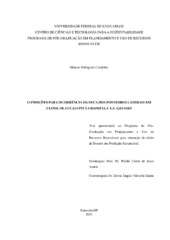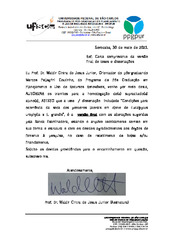| dc.contributor.author | Coutinho, Marcos Pellegrini | |
| dc.date.accessioned | 2021-05-31T14:10:01Z | |
| dc.date.available | 2021-05-31T14:10:01Z | |
| dc.date.issued | 2021-04-30 | |
| dc.identifier.citation | COUTINHO, Marcos Pellegrini. Condições para ocorrência da seca dos ponteiros laterais em clone de Eucalyptus urophylla x E. grandis. 2021. Tese (Doutorado em Planejamento e Uso de Recursos Renováveis) – Universidade Federal de São Carlos, Sorocaba, 2021. Disponível em: https://repositorio.ufscar.br/handle/ufscar/14325. | * |
| dc.identifier.uri | https://repositorio.ufscar.br/handle/ufscar/14325 | |
| dc.description.abstract | The Dried out of Side Tips (DST) in Eucalyptus (Pseudoplagiostoma eucalypti Cheew., M.J. Wingf. & Crous) is a disease that affects the productivity of forest plantations in Brazil. Due to little knowledge about the epidemic, the study deepens, in two chapters, the understanding of the disease in relation to the environmental conditions of the affected areas. In the first article, it was evaluated, for the period of three and a half years, as conditions of humidity, temperature and exclusion, as well as the severity of the disease, in such a way as to age and periods with greater intensity of DST. The experiment was performed in areas undergoing disease outbreaks, where the clone of E. grandis x E. urophylla had been planted, with 3 x 2-meter spacing. The experimental outline had 12 treatments, regarding the eucalyptus resprouting ages, which allowed analyzing the occurrence of DST for different ages and times of the year. The severity of the disease was calculated as from the weighted mean and the monthly in-field assessments, varying from zero to three (minimum and maximum disease infection). The values of severity were used for calculating the disease growth rate. The meteorological data were organized into graphs and the monthly rainfall values compared by the Mann-Kendall (statistical) test. The test showed there was a significant upward trend of rainfall from the first to the second year and from the latter to the third year. The curve of the progress of the disease also shows the difference among the years assessed, besides showing that the disease manifests with greater severity from the third to the sixth month of age, June-October being the months with the greatest incidence of DST. Therefore, the recommendation is to test planting clones susceptible to the disease in October and/or November as a strategy for obtaining plants with a smaller incidence of DST, since larger-sized plants would be able to bear the pathogen in the critical months. In the second article, this study aimed to evaluate the severity of the disease and the environmental conditions that affect it. Thus, from the environmental data of four weather stations, the following conditions were verified concomitantly: relative humidity above 85%, maximum temperature below 28ºC, rainfall in the range of 1-10 mm and leaf wetting time at 24 h, indicating favorable times (June to October), unfavorable (January to March), and transitory (April, November and December) to the disease. In humid months and when the temperature is not limiting, the occurrence of one or more days with all the variables favorable to the pathogen intensifies the disease. The temperature above 28º C, from October, is one of the reasons that makes the severity of the disease reduce in November and return in June. The map generated based on the severity and environmental conditions reveals greater disease risk in the following areas: Barcelona and Taquari, BA and smaller in Pedro Canário, ES. | por |
| dc.description.sponsorship | Não recebi financiamento | por |
| dc.language.iso | por | por |
| dc.publisher | Universidade Federal de São Carlos | por |
| dc.rights | Attribution-NonCommercial-NoDerivs 3.0 Brazil | * |
| dc.rights.uri | http://creativecommons.org/licenses/by-nc-nd/3.0/br/ | * |
| dc.subject | Pseudoplagiostoma eucalypti | por |
| dc.subject | Eucalyptus spp. | por |
| dc.subject | Condições ambientais | por |
| dc.subject | Risco da doença | por |
| dc.subject | Environmental conditions | por |
| dc.subject | Disease risk | por |
| dc.title | Condições para ocorrência da seca dos ponteiros laterais em clone de Eucalyptus urophylla x E. grandis | por |
| dc.title.alternative | Conditions for occurrence of dries out of the lateral pointers in a clone of clone de Eucalyptus urophylla x E. grandis | por |
| dc.type | Tese | por |
| dc.contributor.advisor1 | Jesus Junior, Waldir Cintra de | |
| dc.contributor.advisor1Lattes | http://lattes.cnpq.br/2614953467362376 | por |
| dc.contributor.advisor-co1 | Zauza, Edival Ângelo Valverde | |
| dc.contributor.advisor-co1Lattes | http://lattes.cnpq.br/7064703296745736 | por |
| dc.description.resumo | A Seca dos Ponteiros Laterais (SPL) em eucalipto (Pseudoplagiostoma eucalypti Cheew., M.J. Wingf. & Crous) é uma doença que afeta a produtividade de plantios florestais no Brasil. Em razão do pouco conhecimento sobre a epidemia, o estudo aprofunda, em dois capítulos, o entendimento da doença em relação às condições ambientais das áreas afetadas. No primeiro artigo, avaliou-se, para o período de três anos e meio, as condições de umidade, temperatura e precipitação, assim como a severidade da doença, de forma a apontar idade e os períodos com maior intensidade da SPL. O experimento foi conduzido em áreas de rebrota dos clones Eucalyptus urophylla x E. grandis, no espaçamento 3 x 2 metros, com surtos da doença. O delineamento experimental teve 12 tratamentos, referentes às idades de rebrota do eucalipto, permitindo analisar a SPL para diferentes idades, meses e anos. A severidade da doença foi calculada a partir da média ponderada e avaliações mensais realizadas em campo, variando de zero a três. Os valores da severidade foram utilizados para o cálculo da taxa de crescimento da doença. Os dados meteorológicos foram organizados em gráficos e os valores mensais de chuva comparados pelo teste estatístico de Mann-Kendall. O teste revelou que houve tendência significativa no incremento da precipitação do primeiro para o segundo ano e desse para o terceiro. A curva de progresso da doença também apresenta diferença entre os anos avaliados e, ainda, revela que a doença se manifesta com maior severidade do terceiro ao sexto mês de idade, sendo o período de junho a outubro de maior intensidade da SPL. Dessa forma, recomenda-se testar o plantio de clones suscetíveis à doença em outubro e, ou novembro como estratégia para se conseguir plantas com menor incidência da SPL, pois plantas com um porte maior podem suportar o patógeno nos meses críticos. O segundo artigo, dá continuidade ao primeiro e, analisa a relação da doença e dados meteorológicos de quatro estações da região, com espacialização das informações geradas. O estudo verificou, concomitantemente, as seguintes condições, umidade relativa acima de 85%, temperatura máxima inferior a 28ºC, precipitação entre 1-10 mm e o tempo de molhamento foliar de pelo menos 24 h. Os resultados mostram as épocas favoráveis (junho a outubro), desfavoráveis (janeiro a março) e transitórias (abril, novembro e dezembro) à doença. Em meses úmidos e quando a temperatura não é limitante, a ocorrência de um ou mais dias com todas as variáveis favoráveis ao patógeno intensifica a doença. Valores de temperatura acima de 28º C, após o mês de outubro, bem como a diminuição da umidade relativa em setembro, são desfavoráveis ao desenvolvimento do patógeno, fato que gera redução na intensidade da doença em novembro e retorno em junho. O mapa da favorabilidade apresenta maior risco da doença em áreas do município de Caravelas, BA e menor em Pedro Canário, ES, embora se constate favorabilidade em toda a região do estudo, principalmente, para o segundo ano de avaliação. | por |
| dc.publisher.initials | UFSCar | por |
| dc.publisher.program | Programa de Pós-Graduação em Planejamento e Uso de Recursos Renováveis - PPGPUR-So | por |
| dc.subject.cnpq | CIENCIAS AGRARIAS::RECURSOS FLORESTAIS E ENGENHARIA FLORESTAL | por |
| dc.subject.cnpq | CIENCIAS AGRARIAS | por |
| dc.subject.cnpq | CIENCIAS AGRARIAS::RECURSOS FLORESTAIS E ENGENHARIA FLORESTAL::SILVICULTURA::PROTECAO FLORESTAL | por |
| dc.publisher.address | Câmpus Sorocaba | por |
| dc.contributor.authorlattes | http://lattes.cnpq.br/7413574240098817 | por |


